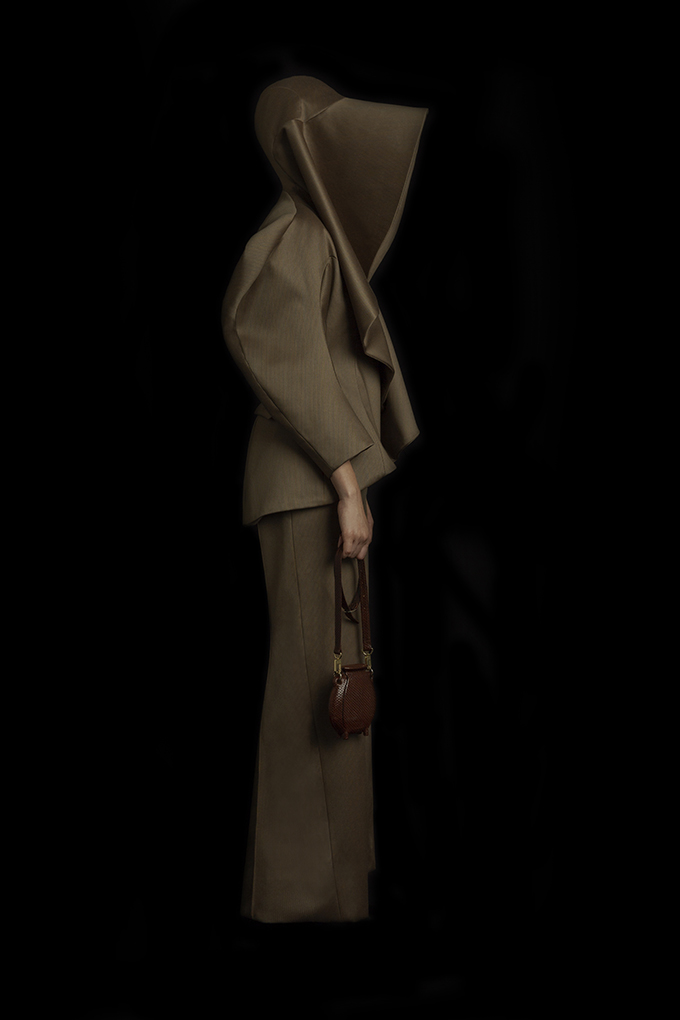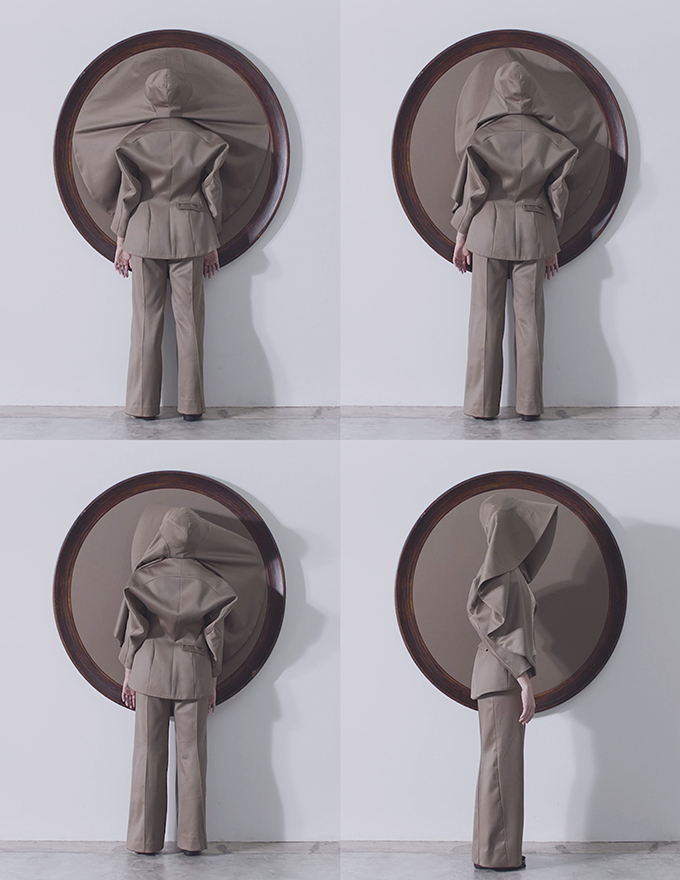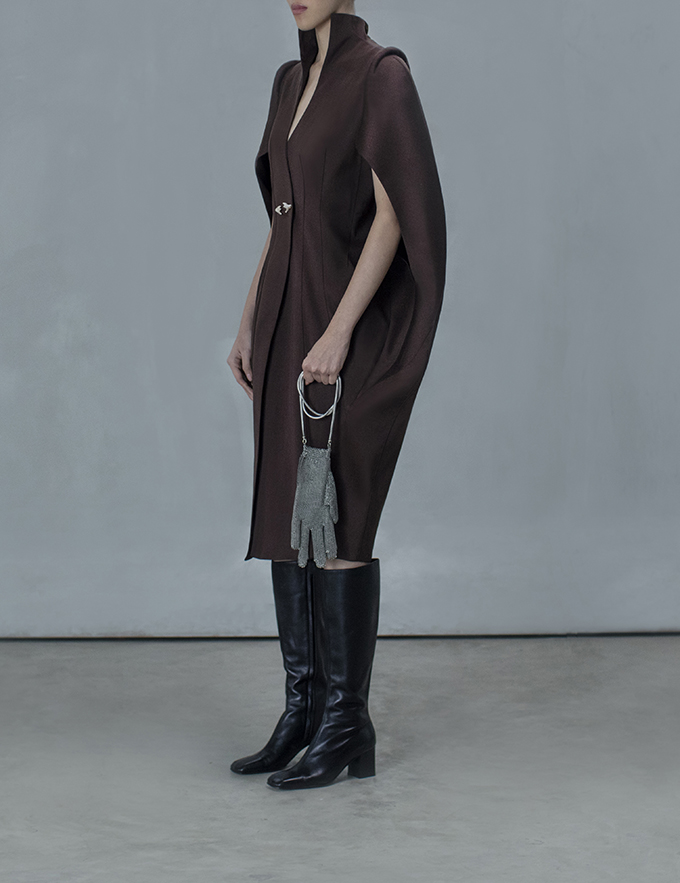Can fashion be furniture? In Grace Ling’s world, the lines are blurry. For an industry that rewards peacocking, fashion has hardly been one to blend into its surroundings. But for this New York-based designer, there is something very human about becoming one with the space you inhabit—particularly in a time where we’ve spent more time at home than ever. Launching her first pre-order collection this month, Ling’s line of bags, jewellery and outerwear will be available to order online on her website.
Formerly interning at the likes of Thom Browne and The Row, the homegrown designer joins the well-trodden path of young designers who then go on to start their own labels. With the help of 3D tech, computer-generated imagery (CGI) and computer-aided design (CAD), she preempts the exact amount of materials needed for her designs. At 24 years old, Ling’s creative voice is already notably distinct as sustainability functions neither as a buzzword nor an afterthought, but an intrinsic part of her design process.
Reflecting on her journey as an emerging designer so far, Ling sits down with Vogue Singapore to discuss her sustainability ethos, fashion tech and the role of a fashion designer today.
Grace Ling’s pre-order collection launches 7 April 2021.

How would you describe your design language?
Eccentric elegance and intelligent femininity. Absurdist yet sophisticated. I resonate deeply with the surrealist art movement and the rational—or irrationalism—behind it has become a kind of philosophy for me.
Tell us more about your creative process—what gets you in the zone of inspiration?
I am often inspired by dystopian films, science fiction, classical music, modern art and furniture. The creative process is an ongoing dialogue with the world of art. I get most of my ideas while doing the most mundane activities like riding the train. I get spurts of abstract ideas and I then try to piece them together through a series of quick sketches. I don’t often know what the story or collection is going to be but all I need is one bag idea or one emotion I want to evoke and I start from there. It’s the same with draping fabric on the human body. I never know what the form is going to end up looking like. I enjoy trusting the process and letting it take me where it wants to go.

You interned at The Row and Thom Browne prior to starting your label. How did your experience there shape your craft?
I learnt about creating with high quality. What I gained most out of Thom Browne and The Row was experiencing the synergy between creatives. There was a kind of design language understood by everyone and that was really beautiful and inspiring.
Your accessories and jewellery take on various shapes and forms of the human body, such as the Butt Bag, Human Mesh Bag and Mesh Hand Bag. What was the inspiration behind this?
The human body is a language that transcends all cultures and backgrounds. I wanted to create wit and light-hearted humour without having to explain much. I was first inspired by a psychological phenomenon often referred to as ‘anthropomorphism’, which refers to the attribution of human characteristics to inanimate objects. From an absurdist perspective, I wanted to see how inanimate sculptures can trigger an emotional response. This is also why the Pot Bag has ‘legs’. I want it to look almost alive. As for the human parts, they become a whimsical allegory of ‘body’ as bodily adornments. There’s also a subconscious sensibility to being a woman. From some of my collections, my jackets are very covered up with little skin revealed. However, there is a Butt Bag displayed on the outside of the jacket. For me, it’s a way to display wit and playfulness through the accessories, while maintaining sophistication and maturity in the garments. I think there is an odd sense of empowerment in that—it’s a different kind of sexy.

How does technology fit into your creative process? Can you tell us a little more about how you incorporate CAD and CGI tech?
I had always been fascinated with 3D printing, so at some point, I started 3D printing bags. The core of my design process involves a lot of 3D tech, CAD and CGI. For every CAD software such as Rhino, there are a few things that one software is really good for. Over the years, I have combined a multitude of CAD software and this has become my design process, it allows me to really push boundaries and create unique forms. CAD is great because it allows me to calculate the exact amount of materials needed and create uniquely with zero-waste.
“Sustainability is a design process and not necessarily just an end product.”
I remember photographing my products and was thinking, “Wow, this looks exactly like my CGI render, do I even need to make the sample?” This opens up a whole lot of opportunity for sustainability around fashion production and business systems. 3D printing also often uses corn-based plastic that is biodegradable. I combine these technologies with traditional forms of craft and this fusion completes a product.

What were some of the challenges in putting this collection together?
Apart from COVID-related challenges, I think it was pretty challenging perfecting each product for our customers. For pieces like the bigger Butt Bag, its shape is doubled for internal support in the bag as well as the outside shell, almost like a Russian doll. Due to the technical complexities in trying to achieve this, I think I redesigned this more than 10 times from scratch. Another challenging piece was the Circle Jacket, it took a lot of precision to get it to fit the wall frame perfectly and function as an alternative to a conventional hanger.

Sustainability is also an integral part of your design ethos. As a relatively young label, what are some things you chose to do differently from a traditional fashion brand, be it creative or technical?
There are two ways I see sustainability: one is that sustainability is a design process and not necessarily just an end product. As I mentioned, 3D tech, CAD and CGI allows me to calculate the exact amount of materials needed and create with zero-waste. Another approach to sustainability is our choice to use high-quality materials like fine wools, silks and eco-brass. We design items with the purpose of outlasting trends and seasons. We focus on its longevity and timelessness and each piece is an investment in that.
“In many ways, the role of a fashion designer is quite similar to that of an artist. Fashion is a projection of culture and upheavals.”
You’ve mentioned that your label will be an ongoing collaboration with different disciplines every season. What does this mean and what can we expect?
Yes, that is my vision because I think fashion should be multidisciplinary, I am often inspired by performance art, film and sculpture. Previously I collaborated with contemporary dancers and performance artists, and then with filmmakers. It is an alternative to runways and I hope to involve people of diverse disciplines as the business grows. Right now, I am currently collaborating with a Paris-based CGI artist, Nik Gundersen, on a CGI short film for the e-commerce launch.

With the backdrop of COVID-19 and political, cultural and environmental change around the world, the way we view fashion has collectively more conscious and considered. What does the role of a fashion designer mean to you in today’s context?
In many ways, the role of a fashion designer is quite similar to that of an artist. Fashion is a projection of culture and upheavals. Sometimes it is manifested literally and yelled aloud, and sometimes it is indirect—in the design process, for example. I think the role of a fashion designer is to provide a firm point of view on these changes through fashion.
Finally, what do you hope for people to feel when they wear your designs?
Ultimately, I want people to feel joy, light-hearted humour and a sense of empowerment.





